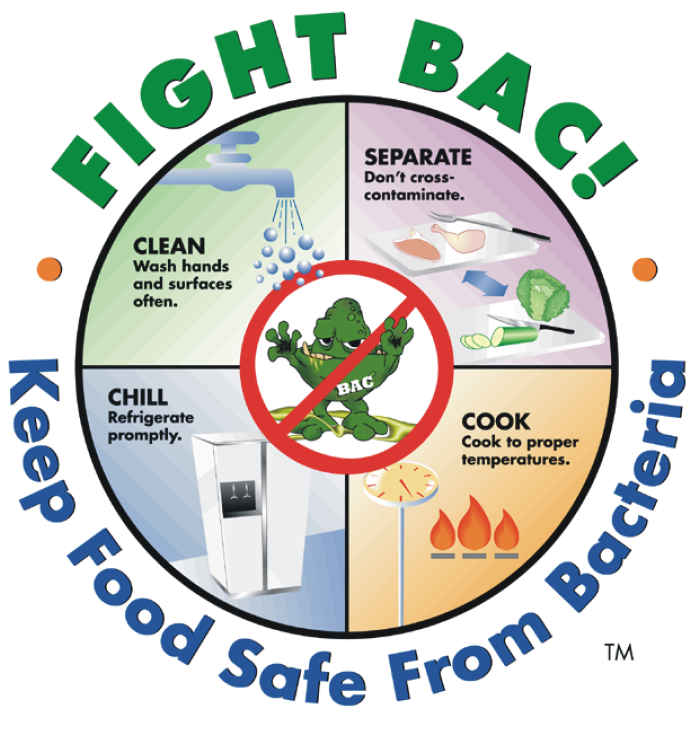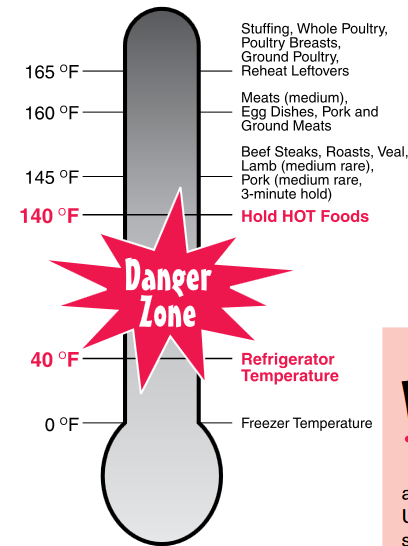Use a food thermometer to check the internal temperature of meat, poultry, casseroles, and other food. Check temperature in several places to be sure the food is evenly heated. Wash the thermometer with hot, soapy water after use.
Several types of thermometers are available, including:
- Oven-safe –– insert 2 to 2½ inches deep in the thickest part of the food, at the beginning of the cooking time. It remains there throughout cooking and is not appropriate for thin food.
- Dial instant-read –– not designed to stay in the food during cooking. Insert probe the full length of the sensing area, usually 2 to 2½ inches. If measuring the temperature of a thin food, such as hamburger patty or boneless chicken breast, insert probe sideways with the sensing device in the center. About 15 to 20 seconds are required for the temperature to be accurately displayed.
- Digital instant-read –– not designed to stay in food during cooking. The heat sensing device is in the tip of the probe. Place the tip of the probe in the center of the thickest part of the food, at least ½ inch deep. About 10 seconds is required for the temperature to be accurately displayed.
Never partially cook food for finishing later because you increase the risk of bacterial growth on the food. Bacteria are killed when foods reach a safe internal temperature.
Don’t use recipes in which eggs remain raw or only partially cooked. Eggs should be prepared immediately after breaking. When possible, substitute pasteurized eggs for raw eggs in cooked dishes.
When preparing food in the oven, set the oven to at least 325°F. Cook food to the safe recommended temperature. Check internal temperature in several places with a food thermometer.
If a convection oven is used to prepare food, you may reduce oven temperature 25°F. Refer to manufacturer’s instructions for additional information.
A microwave oven can be used to prepare food, but care must be taken to make sure food reaches a safe temperature throughout.
- Stir or rotate food midway through the microwaving time to eliminate cold spots and for more even cooking. Cover food.
- Partial cooking may be done in the microwave only if the food is to finish cooking immediately on the range, grill, or in a convectional oven.
- Use a food thermometer or the oven’s temperature probe to be sure the food has reached a safe temperature. Check temperature in several places.
- Observe standing times given in recipes so cooking is completed.
- Check manufacturer’s instructions.
Recommended Cooking Temperatures*
Note: All temperatures in the second column are in degrees Fahrenheit.
Egg and Egg Dishes
| Eggs |
Cook until yolk and white are firm |
| Egg casseroles |
160 degrees |
| Egg sauces |
160 degrees |
Ground Meat and Meat Mixtures
| Turkey, chicken |
165 degrees |
| Beef, veal, lamb, pork |
160 degrees |
Fresh Beef, Veal, Lamb
| Medium rare |
145 degrees |
| Medium |
160 degrees |
| Well done |
170 degrees |
Fresh Pork
| Medium rare |
145 degrees (3-minute hold) |
| Medium |
160 degrees |
| Well done |
170 degrees |
Ham
| Fresh (raw) |
160 degrees |
| Fully cooked (to reheat) |
140 degrees |
Roast Beef
| Cooked commercially, vacuum sealed and ready-to-eat |
140 degrees |
Poultry
| Chicken, turkey (whole) |
165 degrees |
| Chicken, turkey (dark meat) |
165 degrees |
| Poultry - breast |
165 degrees |
| Duck and goose |
165 degrees |
Stuffing
| Cooked alone or in bird |
165 degrees |
Sauces, Soups, Gravies, Marinades
| Used with raw meat, poultry or fish |
Bring to a boil |
Seafood
| Fin fish |
Cook until opaque and flakes easily with fork |
| Shrimp, lobster, crab |
Should turn red and flesh should become pearly opaque |
| Scallops |
Should turn milky white or opaque and firm |
| Clams, mussels, oysters |
Cook until shells open |
Leftovers - 165 degrees
*These USDA consumer guidelines vary slightly from the FDA and North Dakota Food Code temperatures. Foodservice personnel in commercial settings should consult with the food code.

Keep It Hot – Keep It Cold or Just Don’t Keep It!
Danger Zone
Bacteria multiply rapidly between 41 and 140°F. To keep food out of this “danger zone,” keep cold food cold and hot food hot. Keep cold food in the refrigerator, in coolers, or on the service line on ice. Keep hot food in the oven, in heated chafing dishes, or in preheated steam tables, warming trays and/or slow cookers.
When You Chill Food
• Place food in the refrigerator at 40°F or lower.
• Don’t overfill the refrigerator. Cool air must circulate to keep food safe.
• Divide food and place in shallow containers. Slice roast beef or ham and layer in containers in portions for service.
• Divide turkey into smaller portions or slices and refrigerate. Remove stuffing from cavity before refrigeration.
• Place soups or stews in shallow containers. To cool quickly, place in ice water bath and stir.
• Cover and label cooked foods. Include the preparation date on the label.
When You Transport Food
Keep cold food cold. Place cold food in cooler with a cold source such as ice or commercial freezing gels. Use plenty of ice or commercial freezing gels. Cold food should be held at or below 40°F.
Hot food should be kept hot, at or above 140°F. Wrap well and place in an insulated container.
When You Reheat Food
Heat cooked, commercially vacuum-sealed, ready-to-eat foods, such as hams and roasts, to 140°F.
Foods that have been cooked ahead and cooled should be reheated to at least 165°F.
Reheat leftovers thoroughly to at least 165°F. Reheat sauces, soups, and gravies to a boil.
- On Stove Top –– Place food in pan and heat thoroughly. The food should reach at least 165°F on a food thermometer when done.
- In Oven –– Place food in oven set no lower than 325°F. Use a food thermometer to check the internal temperature of the food.
- In Microwave –– Stir, cover, and rotate fully cooked food for even heating. Heat food until it reaches at least 165°F throughout.
It is NOT recommended to reheat foods in slow cookers, steam tables or chafing dishes. This equipment is meant to hold hot foods hot. Reheating in these containers may allow foods to stay in the “danger zone” (41 and 140°F) too long. Bacteria multiply rapidly at these temperatures.
When You Keep Food Hot
Once food is cooked or reheated, it should be held hot, at or above 140°F. Food may be held in oven or on serving line in heated chafing dishes, or on preheated steam tables, warming trays, and/or slow cookers. Always keep hot food hot.
Hot holding for extended periods may reduce the quality of the food.
When You Keep Food Cold
Store in refrigerator set at 40°F. If there is not enough room in the refrigerator, place food in coolers with ice or commercial freezing gels. Always keep cold food cold.




